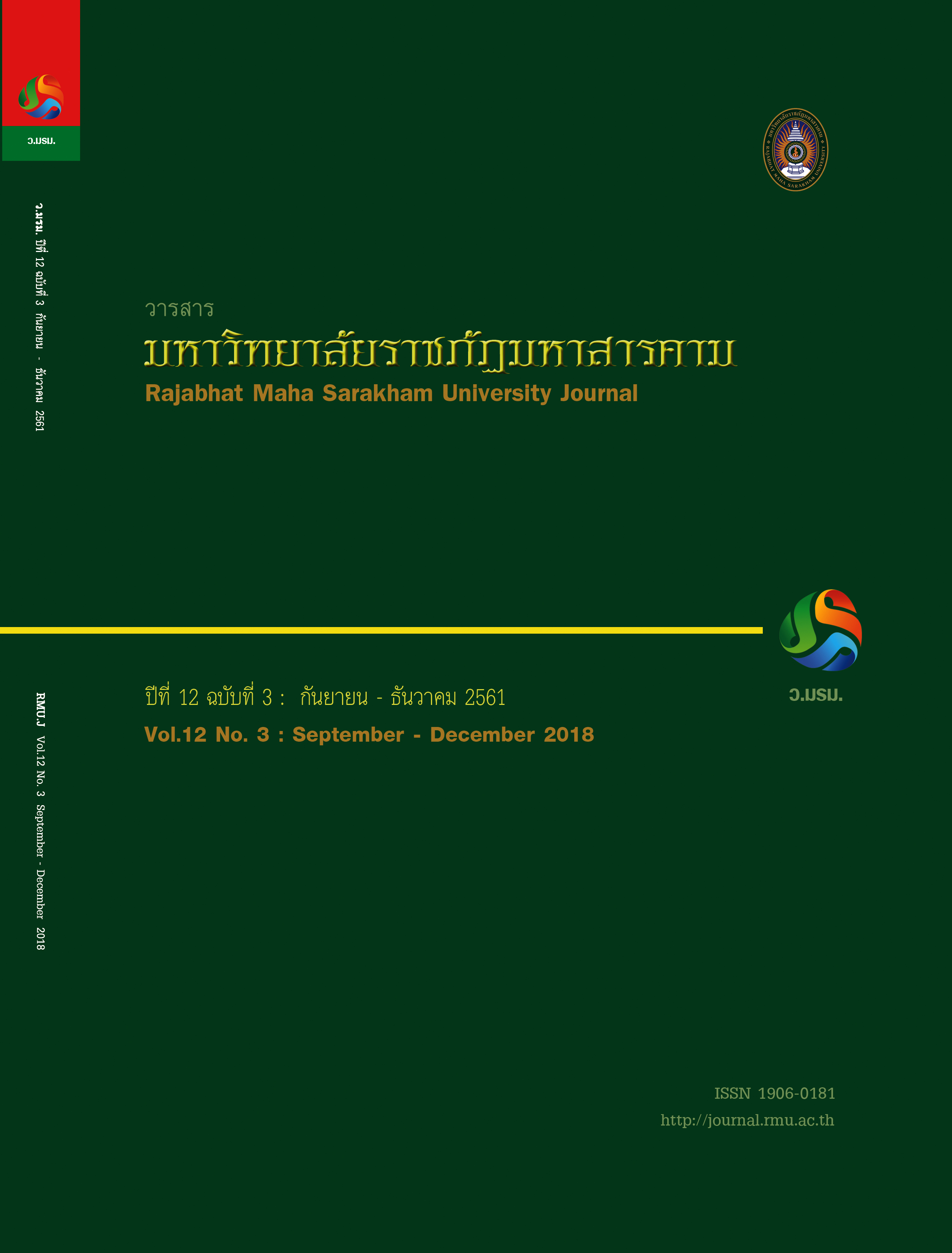กลวิธีการสอนอย่างมีประสิทธิภาพเพื่อส่งเสริมการอ่านภาษาอังกฤษของผู้เรียนภาษาอังกฤษเป็นภาษาต่างประเทศ ในศตวรรษที่ 21
Main Article Content
บทคัดย่อ
บทความนี้กล่าวถึงกลวิธีการสอนอย่างมีประสิทธิภาพเพื่อส่งเสริมการอ่านภาษาอังกฤษของผู้เรียนภาษาอังกฤษ
เป็นภาษาต่างประเทศในศตวรรษที่ 21 ซึ่งทักษะการอ่านเป็นหนึ่งในสี่ทักษะหลักที่สำคัญของการเรียนภาษาอังกฤษ ดังนั้นการจัดกิจกรรมการเรียนการสอนโดยใช้กลวิธีการสอนอ่านอย่างมีประสิทธิภาพสามารถส่งเสริมการอ่านแก่ผู้เรียนได้ กลวิธีการสอนอ่านที่มีประสิทธิภาพที่ถูกนำมาใช้ ได้แก่ KWL-Plus, QARs, DR-TA และ RT การจัดการศึกษาในปัจจุบันเน้นให้ผู้เรียนมีทักษะการเรียนรู้
ในศตวรรษที่ 21 กล่าวคือ ทักษะการคิดวิเคราะห์ การสื่อสาร การร่วมมือและความคิดสร้างสรรค์ รวมถึงทักษะชีวิต อาชีพ และทักษะด้านสารสนเทศและเทคโนโลยี ดังนั้นการบูรณาการทักษะในศตวรรษที่ 21 กับการเรียนการสอนแบบผสมผสาน (Blended Learning) ที่ใช้อินเตอร์เน็ตเป็นสื่อกลาง ช่วยให้ผู้เรียนเรียนรู้ได้อย่างไม่มีข้อจำกัด อีกทั้งสร้างโอกาสในการเรียนรู้เพิ่มขึ้น ผู้เรียนสามารถแลกเปลี่ยนเรียนรู้และส่งข้อมูลถึงกันได้อย่างรวดเร็ว การเรียนรู้ในรูปแบบใหม่ที่มีการปรับใช้เครื่องมือออนไลน์ผสมผสานกับห้องเรียนปกติ เช่น Padlet Canva หรือ Google Classroom เป็นต้น ช่วยเพิ่มพูนการเรียนรู้ของผู้เรียนให้มีประสิทธิภาพและประสิทธิผล
มากยิ่งขึ้น หากผู้สอนนำเอากลวิธีการอ่านและการเรียนการสอนแบบผสมผสานมาประยุกต์ใช้กับเครื่องมือออนไลน์ก็จะสามารถกระตุ้นให้ผู้เรียนเปลี่ยนบทบาทจากการเรียนรู้แบบกระบวนการเรียนรู้แบบตั้งรับ (Passive Learning) เป็นการเรียนรู้ที่ผู้เรียนได้ลงมือกระทำและได้ใช้กระบวนการคิด (Active Learning) ซึ่งเป็นหัวใจหลักในการเรียนรู้ในศตวรรษที่ 21
Article Details

อนุญาตภายใต้เงื่อนไข Creative Commons Attribution-NonCommercial-NoDerivatives 4.0 International License.
1. บทความที่ลงตีพิมพ์ทุกเรื่องได้รับการตรวจทางวิชาการโดยผู้ประเมินอิสระ ผู้ทรงคุณวุฒิ (Peer Review) สาขาที่เกี่ยวข้อง อย่างน้อย 3 ท่าน ในรูปแบบ Double blind review
2. ข้อคิดเห็นใด ๆ ของบทความที่ลงตีพิมพ์ในวารสารมหาวิทยาลัยราชภัฏมหาสารคาม นี้เป็นของผู้เขียน คณะผู้จัดทำวารสารไม่จำเป็นต้องเห็นด้วย
3. กองบรรณาธิการวารสารมหาวิทยาลัยราชภัฏมหาสารคาม ไม่สงวนสิทธิ์การคัดลอกแต่ให้อ้างอิงแสดงที่มา
เอกสารอ้างอิง
Pongpanich, N. (2011). A Study of Problems in English Speaking in Speech Communication of Management Sciences Students in Faculty of Management Sciences Kasetsart University. Humanities Journal. 18(1), 85-97.
Changniam, N. and Tiamtan, P. (2017). The Effects of Reading English Instruction by KWL Plus Technique on Reading Comprehension Ability of Lower Vocational Certificate One Students. Journal of Graduate Studies in Northern Rajabhat Universities. 7(12), 149-160.
Office of the Basic Education Commission. (2008). Guidelines for Participating in Educational Management. Bangkok: The Agricultural Co-operative Federation of Thailand Press.
Upper Secondary Education Bureau. (2015). The 21th Century Learning Guidelines, Retrieved May 10, 2018, from https://webs.rmutl.ac.th/assets/upload/files/2016/09/20160908101755_51855.pdf
Sattrapruek, S. (2017). Flipped Classroom in 21st Century Learning for Development of Learning and Innovation Skills. Academic Services Journal Prince of Songkla University. 28(1), 100-108.
Anugkakul, K. (2015). English Reading. Punyapiwat Journal. 7(1), 232-241.
Goodman, K.S. (1973). Psycholinguistic Universals of the Reading Press. Detroit: Wayne.
Cooper, David J., and others. (1988). What and How of Reading Instruction. (2nd ed.). Ohio: Meritt Publishing Company.
Nunan, D. (1989). Designing Tasks for the Communicative Classroom. Cambridge: Cambridge University Press.
Manowong. S. (2017). Incorporating Online Tools to Promote English Reading for EFL Learners: an Action Research Study. Pasaa Paritat Journal. (32), 98-124.
Aebersold, J. A. and Field, M. L. (1997). From Reader to Reading Teacher. Cambridge: Cambridge University Press.
Kirin, W. (2007). Teaching and the Development of English Reading. Nakhon Pathom: Rajabhat Nakhon Pathom University.
Grabe, W. (2004). Research on Teaching Reading. Annual Review of Applied Linguistics. 24, 44-69.
Carr, E., and Ogle, D. (1987). K-W-L Plus: A Strategies for Comprehension and Summarization. Journal of Reading. 30, 626-631.
Raphael, T.E. (1986). Teaching Question-Answer Relationships. The Reading Teacher. 39, 516-520.
National Behaviour Support Service. (nd. ). Question Answer Relationship (QAR), Retrieved April 15, 2018, from https://www.nbss.ie/sites/default/files/publications/qar_strategy_handout.pdf
Baggett, R. (2006). QAR: Question Answer Relationships with an Example from Canyons by Gary Paulsen, Retrieved April 20, 2018, from http://novelinks.org/uploads/Novels/Canyons/QAR.pdf
Stauffer, R. G. (1969). Directing Reading Maturity as Cognitive Process. New York: Harper Collins College Publishers.
Almasi, J. (2003). Teaching Strategic Processes in Reading. New York: The Guilford Press.
González, N., Moll, L. C., and Amanti, C. (Eds.). (2006). Funds of knowledge: Theorizing Practices in Households, Communities, and Classrooms. Routledge.
Tierney, R. J. et al. (1995). Reading Strategies and Practices (4th ed.). Massachusetts: Allyn and Bacon.
Vacca, R., & Vacca, J. (1996). Content Area Reading (5th ed.). New York, NY: HarperCoIlins College Publishers.
Stauffer, R.G. (1975). Directing the Reading-Thinking Process. New York: Harper and Row.
Klangpracha, N. (2014). The Development of Reading Comprehension Ability for Grade 11 Students Usin Directed Reading – Thinking Activity (DR-TA). Master Thesis. Khon Kaen: Khon Kaen University.
Anderson, R. C. (1984). Role of the Reader's Schema in Comprehension, Learning, and Memory. Learning to Read in American Schools: Basal Readers and Content Texts. 29, 243-257.
Renn, C. E. (1999). The Effects of the Directed Reading Thinking Activity on Second Grade Reading Comprehension. Dissertation, University of Grand Valley State.
Barron, Cecilia. (1990). The Impact of the Directed Reading-Thinking Activity on Critical Thinking Skills in Third Grade Students. Retrieved January 10, 2018, from www.eric.ed.gov/ERICWebPortal/custorn/portlets/recordDetails
Riley. D. (2006). The Effect of Directed reading Thinking Activity on Low Reading Achievement First Grade Students. Dissertation International Abstracts. 32(4), 259-262.
Seftika. (2016). Directed Reading Thinking Activity (Dr-Ta) Strategy To Teach Reading. Smart Journal. 2(2), 121-127.
Palincsar, A. S. and Brown, A. L. (1984). Reciprocal Teaching of Comprehension Fostering and ComprehensionMonitoring Activities, Retrieved March 15, 2018, from https://people.ucsc.edu/~gwells/Files/Courses_Folder/ED%20261%20Papers/Palincsar%20Reciprocal%20Teaching.pdf
Blachwicz, C. and Ogle (2008). Reading Comprehension Strategies for Independent Learners. Second Edition. New York:The Guilford Press.
Tseng, S. and Yeh, H. (2017). Integrating Reciprocal Teaching in an Online Environment with an Annotation Feature to Enhance Low-Achieving Students’ English Reading Comprehension, Retrieved May 3, 2018, from https://doi.org/10.1080/10494820.2017.1412989
Konpan, T. (2006). A Comparison of Reciprocal Teaching Technique and Communicative Language Teaching Technique in Developing Mathayom Suksa 4 Students’ Reading Comprehension. Master Thesis, M.A. (Teaching English as a Foreign Language). Bangkok: Graduate School, Srinakharinwirot University.
Herlina, N. (2017). The Use of Reciprocal Strategy in Teaching Reading Comprehension. Proceedings of the Fifth International Seminar on English Language and Teaching (ISELT-5). (5), 105-112.
Doolittle, P. E., Hicks, D., Triplett, C. F., Nichols, W. D., Yong, C. A. (2006). Reciprocal Teaching for Reading Comprehension in Higher Education: A Strategy for Fostering the Deeper Understanding of Texts, Retrieved April 17, 2018, from http://www.isetl.org/ijtlhe/
Izquierdo. F. V. (2004). Reciprocal Teaching: A Useful Tool in Increasing Student-Talking Time, Retrieved March 12, 2018, from https://americanenglish.state.gov/files/ae/resource_files/04-42-2-h.pdf
Bojovic, M. D. (2017). Blended Learning as A Foreign Language Learning Environment. TEME, Retrieved January 18, 2018, from DOI: 10.22190/TEME1704017B
Graham, C.R. (2006). Blended Learning Systems: Definition, Current Trends, and Future Directions. In C.J. Bonk & C.R. Graham (Eds.), Handbook of Blended Learning: Global Perspectives, Local Designs. San Francisco, CA: Pfeiffer.
Jaitham, L. (2015). Blended Learning Case Study: Siriwang Wittayakarn School. Master’s Project, M.Sc. Bangkok: Mahanakorn University of Technology.


